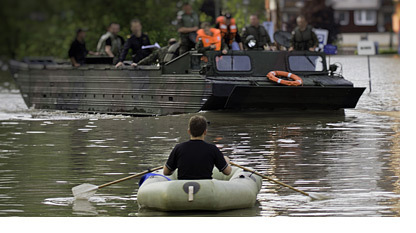 The City of Houston sits in a low coastal area, surrounded by bayous and rivers. As such, it is prone to flooding from rains and hurricanes. In the latter part of April 2016, a major storm system stalled over the area, deluging the fourth-largest city in the United States with tremendous amounts of water. At least eight people died, according to news media reports, and more than 1,200 were rescued from rising waters. More than 7,000 homes were flooded or seriously damaged in the metropolitan area. Early damage estimates came in at over $60 million and is expected to rise.
The City of Houston sits in a low coastal area, surrounded by bayous and rivers. As such, it is prone to flooding from rains and hurricanes. In the latter part of April 2016, a major storm system stalled over the area, deluging the fourth-largest city in the United States with tremendous amounts of water. At least eight people died, according to news media reports, and more than 1,200 were rescued from rising waters. More than 7,000 homes were flooded or seriously damaged in the metropolitan area. Early damage estimates came in at over $60 million and is expected to rise.
This was a natural disaster so colossal that the recovery effort is certain to extend for months after the floods receded.
Originally posted on the AtHoc blog by Business Development Manager for AtHoc, John Linstrom.
Crisis communications planning for these types of severe incidents typically consists of specific templates and coordinated activities for specific situations. Floods at this scale, however, represent an entirely different type of challenge. In effect, Houston’s flood was not a single natural disaster. It was many, all occurring at the same time, and all buried under the same deluge of extreme rain.
Each rescue in a flooded neighborhood represents one type of emergency. Impassable roadways are another, since massive amounts of traffic must be rerouted as roads become swamped. Fires start when electrical systems short out – and fire departments must struggle to move units and personnel into dangerous, submerged areas.
The reservoirs surrounding Houston have had to undergo controlled releases of water to avoid being overtopped. A failure there would represent an even greater level of catastrophe. The releases themselves will slow the rate at which floodwaters will be able to recede.
Watercraft of all types and sizes in the port area or the shipping channel down to Galveston needed to prepare to be guided out of the area to safer harbor on short notice. At the same time, debris from the floods and elevated water levels made navigation more dangerous and increased the chance that one of these vessels or its crew might need to be rescued.
After the waters have returned to their normal levels, buildings will need to be inspected. Mud and debris will need to be removed. Buildings weakened by the flood will have to be repaired or rebuilt. Areas covered with toxic sludge will need to be rehabilitated.
Every one of these scenarios constitutes an emergency, in and of itself, requiring carefully planned and executed crisis communications. Houston’s April 2016 region-wide flood – ostensibly one natural disaster – is, in fact, many overlapping natural disasters, all of which must be managed in real time to save as many lives and protect as much property as possible.
That’s why an investment in crisis communications software has to do more than help organizations respond to specific events. It has to scale to larger versions of those events – and it has to support massive, chaotic situations when multiple emergencies overlap, placing huge strains on businesses, first responders and government agencies, all at the same time.
Flooding at this scale is rare, but it happens, and the low-lying areas affected are somewhat predictable. The best preparedness planning and response solutions will be of little effect if large-scale coordination and testing have not been designed and completed, across the entirety of the areas at greatest risk.
Organizations need to plan for overlapping crises and seek solutions that scale for this type of massive, regional event. And that scalability should be an essential requirement for anyone seeking to purchase emergency planning and crisis communications hardware, software or services.
If you’re interested in learning more about AtHoc’s networked crisis communications platform, tune into one of the upcoming AtHoc product demo webcasts May 4 or May 18. Visit BlackBerry Enterprise Webcast Central to get more information or to register.